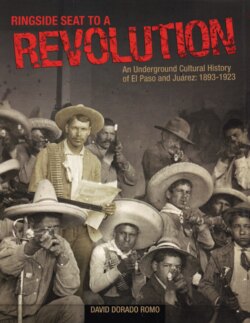Читать книгу Ringside Seat to a Revolution - David Dorado Romo - Страница 34
На сайте Литреса книга снята с продажи.
Оглавлениеfor days after her recovery. She talked about spiritual
visions she’d had while she was unconscious. Teresita
told her father that she heard voices instructing her to
cure the sick and revealing to her that she had impor-
tant work to do among the Indians.
Teresita’s sudden awakening from her coma
transformed her from a curandera to a miracle worker
in the eyes of the community. Black Elk and other
indigenous healers had undergone similar
transformations. Among Native
Americans, seizures or loss of con-
sciousness often preceded the
discovery of healing powers.
When Teresita resumed
her practice of curanderis-
mo, her patients looked
at her with new eyes.
Word spread through-
out the region that she
had resurrected from
the dead; people
saw her abstracted
demeanor and strange
behavior as evidence
of a mysterious posses-
sion. Even after her
recovery, Teresita fre-
quently fell into short
trances. Upon regaining con-
sciousness, she would make
pronouncements about the
future—she could predict rain, torna-
does, accidents, the arrival of a friend,
Teresita Urrea, ca. 1897.
(Southwest Collection,
Texas Tech University.)
the death of a relative or the birth of a
baby. She had powers that would be
associated today with a psychic. An El
Paso family had a wax statue made in
honor of Teresita for helping them find the body of
their drowned son.44 When many of her predictions
came to pass, the villagers took it as another sign that
Teresita was divinely inspired.
Mariana Avendaño witnessed many of these
powers firsthand. Avendaño had promised to
Teresita’s devoted servant for life after Teresita healed
her during a paralysis brought on by a fever.45 She
would stick around for more than a decade, accom-
pany Teresita to El Paso and raise Teresita’s two
daughters after her death.
Avendaño claimed Teresita possessed another
extraordinary power that she shared with only her
closest friends—astral projection. Mariana said she
had accompanied Teresita during several out-of-body
voyages herself. At night, after a hard day’s work of
healing, Teresita would appear to her, as if
in a dream, and they would fly hand
in hand over the pyramids of
Tenochtitlán, the beaches of
Acapulco or over the water
lilies of Xochimilco.46
Another close
friend of Teresita told
anarcho-communist
historian
José
Valadés a similar
story in the 1930s.
“I’ve accompanied
Teresita in some of
her voyages,”
Josefina Félix said
during an oral histo-
ry interview. “But I
can’t explain how that
happened. She would
wake me up when we
slept together, invite me
somewhere and we would
find ourselves there instanta-
neously. We would stay there a
while, converse and see everything
we wanted to see.”47
In the fall of 1896, when a
rebellion broke out in several towns
along the U.S.-Mexico border waged in Teresita’s
name, rumor had it that the young miracle worker had
used her powers of astral projection to lead the revolt
against the soldiers of Porfirio Díaz. Although she was
hundreds of miles away in El Paso, federal soldiers
claimed they saw Santa Teresa leading a group of
rebels at Nogales, Sonora. They said she was riding
upon a white horse that hovered above the ground.
44
Anita Urrea Treviño, interview by W. Holden. Holden Collection, Texas Tech University. “In 1915 or 1916, Anita went to the house of Manuel and
Leberata [sic] Vargas in El Paso. In this house was a wax statue of Teresa, dressed in beautiful garments, and under glass. The Vargas’ had made the
statue, took it to the Exposition in St. Louis where it won first prize. They built their house with the prize money. Anita recognized Teresa’s dress.
The reason for making the statue was that Mrs. Vargas lost her son in the river and asked Teresa what had happened to her son. Teresa told them
where to find the body in the river. They were so grateful they made a life-sized statue of Teresita.”
29
45
Tomasita Urrea García, interview by W. Holden, January 16, 1962. Holden Collection, Texas Tech University.
46
Laura Urrea Van Order, interviewed by W. Holden, January 17, 1962. Holden Collection, Texas Tech University.
47
La Opinión, March 7, 1937.
